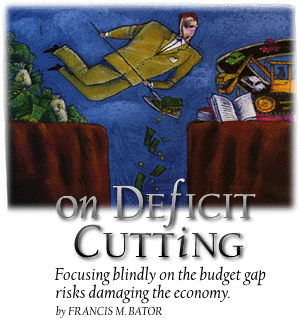Main Menu · Search · Current Issue · Contact · Archives · Centennial · Letters to the Editor · FAQs
![]()
Main Menu ·
Search · Current Issue · Contact · Archives · Centennial · Letters to the Editor · FAQs

The budget resolution passed last year by the Congress-and the budget debate since-make one want to cheer and cry at the same time. Cheer, because they reflect a newfound determination to rein in the rapidly growing deficits embedded in the post-1998 baseline budgets. Cry, because both the words and the music reveal a fundamental misunderstanding of what purpose deficit cutting is meant to serve. Propelled by anti-government fervor ("the market is rational, the government is dumb") and confused about ends and means, the Congress is apt to enact-and the President may accept-budgets that are harmful in the near term and ineffective in the long term. Much of the harm will be visited on people who are poorly placed to withstand it.
First Principles
The object of deficit cutting is not to save the government money, or even to enable it to pay its bills without borrowing. Money is not scarce as a fact of nature-the government (with a lower case "g") can produce it for nothing. We contrive to make money scarce. How scarce we make it, and what we do about federal spending and taxes, should depend on the effect of those actions on the production and distribution of the things that are scarce: the goods and services (current and future) that people want-or, equivalently, on the use we make of the workers, factories, and other inputs needed to produce those goods and services. Inflation comes into consideration to the degree that it affects production and distribution.
The Macroeconomic Task
The perennial task of macroeconomic policymakers is to keep total spending on domestically made goods and services-and, consequently, the Gross National Product we actually produce-growing in step with the inflation-safe capacity of the economy to produce them (potential output). But during the next decade or so, U.S. policymakers will face another task as well, having to do with the composition of spending. Since the early '70s, productivity and real income have grown, on average, very slowly. The remedy for that, it is widely agreed, is a shift in spending, and thus in GNP, away from consumption (private plus public) toward investment as economists define it: spending on new plant and machinery; on new infrastructure and housing; on research, education, and training; and, last, foreign spending on our output (exports) that exceeds our spending on their output (imports). The resulting net exports count as investment because they increase our holdings of foreign assets net of foreign holdings of American assets.1
Shifting the composition of GNP from consumption towards investment, while keeping the sum of the two-total spending on U.S.-made output-growing in line with potential output, calls for two sets of measures:
Means and Ends
A practical politician might argue, when it comes to deficit cutting, that clarity of purpose doesn't really matter. Why not rely on the public's fear of deficits and debt to make necessary but painful policies palatable? As long as we do the right thing, who cares that it is done for the wrong reason?
That is a dangerous strategy. Mesmerized by the deficit, we are unlikely to do the right thing. Specifically:
When total spending is appreciably below potential output and a lot of workers and capacity are idle, we can have more investment without reducing consumption. In fact, under those circumstances investment is likely to be constrained by insufficient consumption spending. Few businesses will choose to expand capacity when faced with falling orders, rising inventories, and a lot of idle capacity, no matter how low interest rates fall.
The first line of defense against a recession is for the Federal Reserve to drive interest rates down. But in a full-scale recession-or when the gap between actual and potential output is very large and not shrinking-demand-boosting fiscal action may be appropriate even though it would make the deficit temporarily even larger than the recession would have automatically made it.
Main Menu ·
Search · Current Issue · Contact · Archives · Centennial · Letters to the Editor · FAQs
![]()